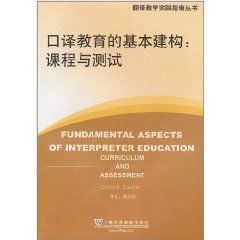內容簡介
《口譯教育的基本建構:課程與測試》(FundamentalAspectsofInterpreterEducation)是一本值得專業教師去學習、思考和研究的口譯專業論著,能幫助大家了解口譯,提高口譯教學能力和掌握口譯考試方法,能促使開設口譯專業的學校找準方向,使專業教師少走彎路。除此之外,《口譯教育的基本建構:課程與測試》把理論研究與實證研究結合了起來,對口譯教學進行研究,並嘗試解決口譯教育中的現實問題。這些都值得從事口譯教育和口譯研究的專業人士學習和思考。
《口譯教育的基本建構:課程與測試》由原蒙特雷國際研究學院高級翻譯學院(GraduateschoolofTranslationandInterpretation,MontereyInstituteofInternationalStudies)的口譯教師大衛·B·索亞(DavidB.Sawyer)以該學院的口譯教學為案例,在對口譯課程與專業評估理論進行研究的基礎上撰寫而成。作者通過理論與實證研究,提出了經過改良的課程模型。通過對如何把高效度、高信度的評估整合到課程中這一問題的探討,作者為口譯課程與口譯評估這一研究領域開闢了新的研究空間。
圖書目錄
Figures and tables
Preface and acknowledgements
CHAPTER 1 Introduction
1. Challenges facing interpreter education
2. The integrative role of assessment
3. The objectives of this book
4. Methodological considerations
5. Overview of contents
CHAPTER 2 Interpreter education literature
1. Curriculum
2. Expertise
3. Assessment
4. Language transfer competence
5. Conclusions
CHAPTER 3 Fundamental aspects of curriculum
1. Definitions
1.1 The official curriculum
1.2 The hidden curriculum
2. Foundations
2.1 Philosophy
2.2 History
2.3 Psychology
2.4 Sociology
3. Guidelines
3.1 Educational philosophy
3.2 The aims of instruction
3.3 Program goals
3.4 Teaching objectives
3.5 Curricular implications
4. Approaches
4.1 Scientific - curriculum as process
4.1.1 The computational view of the mind
4.1.2 Skills and abilities in Instructional Systems Design
4.1.3 The cognitive psychology of expertise
4.1.4 Levels of expertise in interpreting
4.1.5 Implications for curriculum sequencing
4.2 Humanistic - curriculum as interaction
4.2.1 A community of professional practice
4.2.2 Cognitive apprenticeship
4.2.3 Reflective practice
4.2.4 SituatedCognition and Learning
4.2.5 Implications for the learning environment
5. Models
5.1 Curriculum models according to Arjona
5.2 Curriculum components
6. Steps toward effective curriculum design
7. Conclusions
CHAPTER 4 Foundations of interpreter performance assessment
1. Concepts
1.1 Validity
1.2 Reliability
1.3 Subjective and objective testing
1.4 Measurement scales
1.5 Formative, summative, and ipsative assessment
1.6 Test specifications
2. Integrating curriculum and assessment:
Developmental milestones
2.1 Entry-level assessment
2.2 Intermediate assessment
……
CHAPTER 5 Introduction to the case study
CHAPTER 6 Case study Part I: Translation and interpretation competence
CHAPTER 7 Case study Part II: Survey of exam jury members
CHAPTER 8 Case study Part Ⅲ: Analysis of exam texts
CHAPTER 9 Implications of the case study
CHAPTER 10 Curriculum enhancement: An integrated Y-track model
Outlook: On the political and ethical consequences of test validation
Notes
APPENDICES
Appendix A
Appendix B
Appendix C
References
Name index
Subject index

